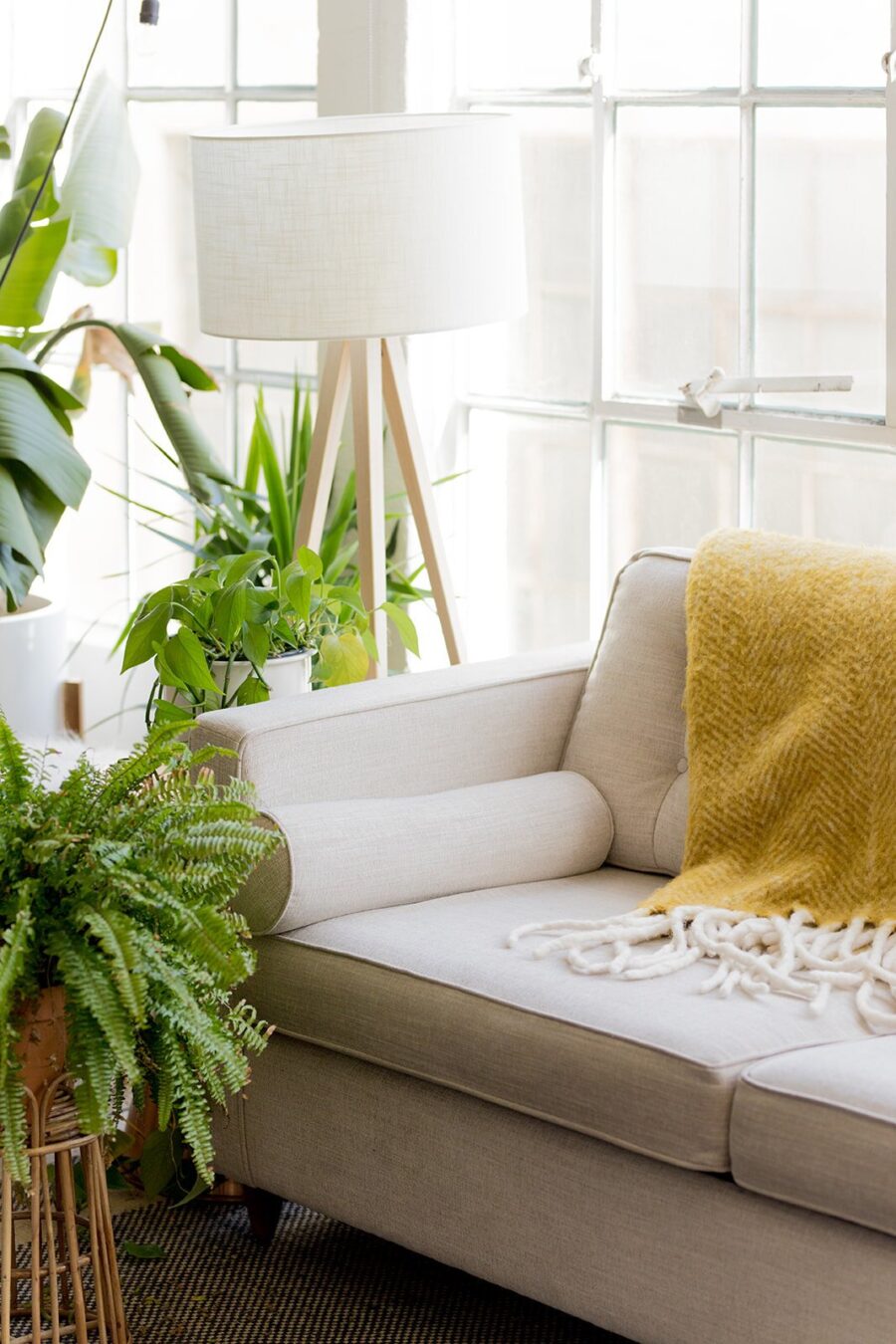
How To Thrift Shop For Secondhand Furniture
Secondhand Furniture—Trash Or Treasure?
I’m a sucker for thrift shopping. Even better? Free roadside furniture. Some finds have proven useful, like the nightstand I had for eight years. Others are simply about adding joy to my home, like the abstract “trash painting” that pulls together my living room colors. And some free furniture finds have proven to be very, very, unforgivably gross; I’ll spare you the details, but let’s just say people leave strange things in dresser drawers. You can’t win if you don’t play the game, right?
If roadside treasures and free curb alerts are not your things (which is fair), thrift shopping for used furniture can be a more enjoyable and predictable experience. You may be no stranger to shopping secondhand for clothing, but furniture is much more of an investment—and takes up significantly more space.
With garage sale season around the corner, now’s the perfect time to brush up on some furniture thrifting basics! Here’s everything you need to know to get started. And if you’re short on time and can’t make it to the thrift stores, you can always shop our favorite brands for new sustainable furniture.
What To Look For With Used Furniture
Are you sick of hearing the advice to create a mood board yet? Well, here it is again: Create a mood board for your home. Knowing what you want before you start shopping for your used furniture helps you move through thrift shops and garage sales more quickly. A thrifting trip without goals can leave you with eight paintings and no couch—which is what you really needed in the first place. Enjoy those paintings while you sit on the floor, I guess?
“A thrifting trip without goals can leave you with eight paintings and no couch—which is what you really needed in the first place.”
I’d also recommend getting a grasp on how much you’re willing to spend and how much you’re willing to DIY. Some thrifters will spend more on furniture in perfect condition, while others are excited about paying much less for a DIY project.
Here are the things I look for in a piece of furniture when deciding on the perfect fit:
-
Materials. What is the piece made of? Real wood is a real perk, whereas particleboard furniture is more affordable but won’t last as long.
-
Comfort. Take a seat—literally. Make sure chairs and sofas are comfortable and offer you the support you want.
-
Stamping. Look at furniture tags or underneath for logo imprints and stamping. (Dresser stamps are often inside drawers.) A quick Google search can usually tell you the piece’s age, quality, and/or value.
-
Compare it to other items. If the furniture is from an individual seller, check out the quality of their other items, or ask the seller where they got the piece to get a better backstory and understand why they’re selling it.
What To Avoid With Used Furniture
Some concerns, like tears and small stains, will vary based on your tolerance. If you’re on a budget and don’t mind imperfections, dings and dents work in your favor to reduce the cost. Sometimes a furnishing is too beautiful or unusual to pass up, even with its flaws. Don’t worry—stains and bad floral upholstery don’t stand a chance against YouTube’s tutorials. Do some digging!
That said, some used furniture finds are just an investment piece of trash (or recycling). Here’s what to consider to avoid buying something you’ll regret:
-
Major stains. If the fabric is beyond repair and you’re not about to get it professionally cleaned or reupholstered, leave it behind for the buyer who will.
-
Smoke. Give each furnishing a quick smell test for smoke. There are some DIY options for removing this smell (though it’s not easy); just make sure it feels worth your time. This goes for pet urine, too. 😱
-
Water damage and mold. Check the inner workings for warped wood, swollen particleboard, and any signs of mold, especially with fabric. If there is water damage, be cautious—you never know what kind of water it came in contact with.
-
Bugs. Look for evidence of chewing or burrowing in upholstery or wood. Remove pillows, drawers, and even cushion covers to inspect underneath.
“Sometimes a furnishing is too beautiful or unusual to pass up, even with its imperfections.”
Where To Shop For Used Furniture
1. FREE FINDS
My neighborhood is densely populated and always seems to have new curbside offerings. But if you’re looking for furniture shopping that is a little more structured, check out Craigslist’s For Sale > Free Stuff section. Freecycle is an entire community based around free and bartered items. Or, search for “curb alert” hashtags or accounts for your city—like the Curb Alert NYC Instagram account. Exercise caution with anything online, and bring a friend along if you’re heading to an unfamiliar location.
2. THRIFT SHOPS
It takes time to identify the best local thrift shops for furniture. Once you do, you can plan out a whole furniture-shopping circuit for when your needs (or wants) change. Goodwill and Salvation Army are familiar places to start, but keep an eye out for smaller local organizations, too.
“I like to look for local home and lifestyle bloggers in my city to see where they shop for secondhand furniture.”
I like to look for local home and lifestyle bloggers in my city to see where they shop for secondhand furniture. I discovered the treasure trove St. Vincent de Paul of Los Angeles that way—it lives up to the hype as the largest thrift store in LA. While I haven’t found the perfect round dining table there yet, you better believe I’ll be returning until I do.
You can save some money by waiting until sale days, but you’re always going to get the best selection of furniture on the day everything is restocked. Politely ask an employee for tips on the best day to shop for new inventory and plan accordingly.
3. INDIVIDUAL SELLERS
Buying furniture directly from its most recent owner is the best way to get a feel for why it’s being sold in the first place. You can ask about damage, pets, and when and where the piece was purchased originally. (This way of buying used furniture is an especially good option if you have serious allergies.)
Use Craigslist to find garage sales in neighborhoods to save you from traveling all over town. You can find pristine vintage furniture at estate sales (this website will help you find one in your city). OfferUp and Facebook Marketplace can connect you with sellers directly as well. If you’re no stranger to delivery fees, eBay can help you find exactly what you want. My brother even bought a vintage truck on eBay—who knew?
And best yet, leverage your own network and keep your ears open for new opportunities; I scored a used couch for $40 from a friend of a friend. Was it beautiful? No. But it was functional, which was what I needed most at the time, and looked as good as new after I took a Rug Doctor to it!
4. CURATED RESALE SHOPS
Resellers carefully vet the used furniture they place for sale and sometimes even clean them—because the seller’s reputation depends on quality. If you’re willing to spend the extra money for a more curated and clean selection, vintage furniture shops and online resellers are the way to go.
“Resellers carefully vet the used furniture they place for sale and sometimes even clean them—because the seller’s reputation depends on quality.”
Etsy and Chairish are user-friendly sites for finding designer home goods, and many vintage sellers have Instagram accounts as well. Be sure to check the seller’s reviews beforehand to see if buyers have been satisfied with the quality, condition, and shipping of their purchases. If it’s an absolute must-have, experienced sellers can ship even large items cross-country.
Delivery Options For Secondhand Furniture
If you’re shopping from a thrift store, vintage store, or other local in-person option, ask the seller if they have delivery options. Explore local delivery services, including Dolly and TaskRabbit, before you shop, so you know how much delivery might cost you. Even asking your friend network on social media might be worth it—you never know who might help you pick up a dresser in exchange for a friendly lunch or a cool $20.
Building a thrifted home is an affordable way to make your space unique and perfectly curated to your own aesthetic. No one else in the world has the exact combination of thrifted decor as I do, and I wouldn’t have it any other way. 🛋️
“Explore local delivery services before you shop, so you know how much delivery might cost you.”
Have you shopped for used furniture? Drop your thrifting tips in the comments below!
Emily Torres is the Editorial Director at The Good Trade. She’s a Los Angeles transplant who was born and raised in Indiana, where she studied Creative Writing and Business at Indiana University. You can usually find her reading or writing, caring for her rabbits, or practicing at the yoga studio.





